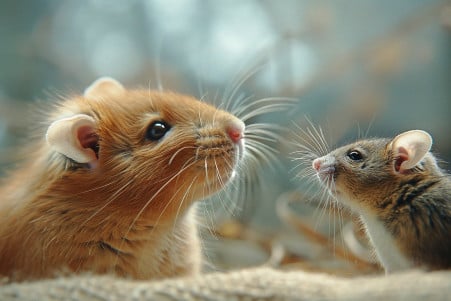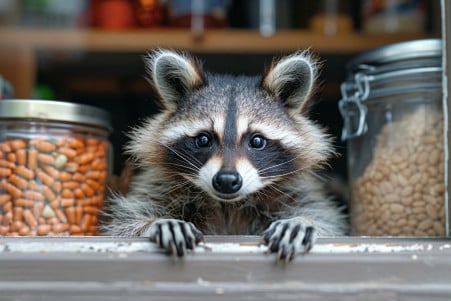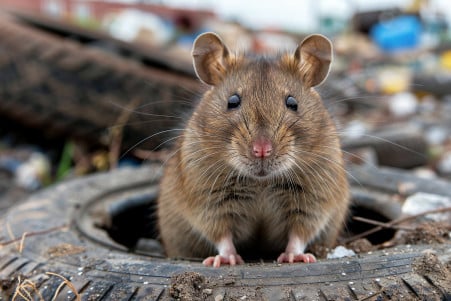Do Rats Eat Cockroaches? Uncovering Nature's Surprising Symbiosis
27 April 2024 • Updated 27 April 2024

Whether you're interested in the mysteries of pest control or the nuances of rodent biology, the question of whether rats eat roaches is an intriguing example of the way the natural world and human society intersect. Rats are opportunistic omnivores and will eat a wide variety of foods, including insects such as cockroaches. Although they are not a preferred food source, rats will eat cockroaches when other food is scarce, taking advantage of the protein source that is most readily available in their environment.
In this article, we'll take a closer look at this unexpected predator-prey relationship, drawing on scientific research that has investigated the feeding patterns and characteristics of rats and cockroaches. Not only does this work help us understand the ecological relationships that are involved, but it also has implications for understanding urban ecosystems and coming up with ways to control pests. By learning more about how these two species behave and how they interact with one another, we can learn more about how nature works and how it manages to survive in even the most inhospitable environments of our cities.
Do rats eat cockroaches?
The Health Risks: Diseases Transmitted from Roaches to Rats
The idea that rats eat cockroaches has some important implications when it comes to the potential transmission of diseases and the health risks that could be involved. Cockroaches can transmit a variety of harmful pathogens indirectly through contamination, including salmonellosis, cholera, dysentery, and gastroenteritis, according to Western Exterminator. Rats can become infected with these diseases by eating cockroaches that have been infected or by coming into contact with their feces and saliva.
Rats are also known to carry more than 35 diseases, many of which can be transmitted to humans through handling rats, contact with their feces, urine, or saliva, or rodent bites, according to the CDC. In addition, rats can also transmit diseases to humans by acting as vectors for other pests that have fed on infected cockroaches, as explained in an article by Life After Bugs. This is how diseases like hantavirus, leptospirosis, salmonella, rat-bite fever, and even plague can be transmitted.
Knowing about this predator-prey relationship is important for minimizing health risks and creating effective pest control plans. As a study in PMC explains, cockroaches are both reservoirs and vectors for many food-borne pathogens that rats can be exposed to and then spread. This knowledge can be used to help create plans that will disrupt the cycle of disease transmission between these two tough urban pests.
Predatory Behaviors: How Rats Hunt and Kill Cockroaches
Rats display a variety of predatory behaviors and hunting techniques when preying on cockroaches. According to a study that examined predatory behaviors in small mammals, rats use a combination of sensory cues to find and hunt their cockroach prey. These cues include visual, tactile, auditory, and olfactory stimuli that enable the rats to determine the presence, location, and movements of the cockroaches.
The predatory sequence is organized in a series of stages, as outlined in a study that looked at the neurocircuitry of predatory hunting. The stages include searching for and detecting the prey, pursuing the prey, attacking the prey, and finally, consuming the cockroach. This sequence of predatory hunting is "hardwired" and instinctual, which allows rats to effectively prey on cockroaches.
It's worth noting that the researchers observed some differences in the predatory behaviors of adult and juvenile rats. Juvenile rats, for instance, had a higher percentage of "bites," "capturing the prey with paws," and "handling" components in their predatory stereotypes than adult rats. This indicates that the predatory behavior of juvenile rats is still developing and that they may be less successful in hunting and consuming cockroaches in a single bout.
This detailed look at predatory behaviors sheds light on the predator-prey relationship between rats and cockroaches and leads into the next section, which examines how the two species interact and compete when they share the same environment.
Coexistence and Competition: Rats and Roaches in Shared Habitats
Rats and cockroaches are common in urban and residential environments, and their habitats often overlap, leading to competition between the two species. According to a study of invasive rat species, the three most widespread species, black, brown, and Pacific rats, have been introduced to tropical islands around the world and have caused significant damage through predation and competition. These rats can also achieve very high population densities, with Pacific rats reaching over 100 per hectare and black rats reaching up to 119 per hectare, densities much higher than those in temperate zones.
This coexistence has led to concerns about the potential for rats and cockroaches to act as reservoirs and vectors for antimicrobial-resistant (AMR) microorganisms, which could pose health risks to humans, as noted in a study on AMR in insects, rodents, and pets. In particular, cockroaches have been found to carry AMR bacteria, which can be transmitted to rats and potentially transmitted to humans.
At the same time, cockroaches also have an important ecological role, breaking down organic matter and cycling nutrients in the environment, as noted in a video by the American Museum of Natural History. They are also an important food source for many small vertebrates in tropical ecosystems. Balancing the complex interactions between rats and cockroaches in shared habitats is important for addressing public health concerns and maintaining ecological equilibrium.
Integrated Pest Management: How to Get Rid of Rats and Cockroaches
Integrated Pest Management (IPM) has been shown to be a successful method for getting rid of both rat and cockroach infestations in multifamily housing. The U.S. Department of Housing and Urban Development explains that IPM is based on the idea that the more you know about pests, the better you can control them.
IPM starts with non-chemical control methods that are based on an understanding of pest biology and behavior in order to prevent infestations.
For cockroaches, this includes sanitation, such as cleaning to remove food and water sources, and exclusion, such as sealing cracks and crevices. It also includes monitoring, such as using traps, and control, such as using baits instead of sprays, as described in an article by Food Safety. Insect growth regulators can also be used to prevent cockroach reproduction without affecting the effectiveness of baits.
For rodents, IPM includes sanitation and exclusion, as well as non-chemical control methods like pre-baiting with non-toxic grains before introducing a slow-acting toxicant, and habitat modification, such as removing clutter to eliminate rodent harborage, as outlined in the EPA's guidance. Trapping is more effective for mice, while rats are more likely to be controlled with baits. Rats also need a water source and are neophobic, which means they are afraid of new things.
All of these methods are most effective when everyone in a building works together, including residents, maintenance staff, and pest management professionals, according to the EPA's resources. By using an integrated and knowledge-based approach, the biology and behavior of pests can be used to control them in a way that is safer and more effective.
Conclusion: Living With Nature's Resilient Survivors
The relationship between rats and cockroaches is a testament to the incredible adaptability and resilience of these urban survivors. While the predator-prey relationship between these two species has important public health implications, it is also important to understand this relationship in order to effectively manage these pests.
By recognizing the ecological niches of these species and taking a holistic approach, we can learn to live with these tenacious pests in a way that minimizes their impact while respecting the complex web of life in our shared spaces.


